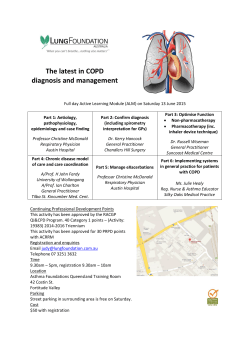
COPD in Rural Practice Carolyn Hull, RN, MSN, DNP
ENVISION ENGAGE INNOVATE COPD in Rural Practice Background Carolyn Hull, RN, MSN, DNP-FNP Candidate, UA CON RHPP (CDC, 2011; GOLD, 2013) Yuma Regional Medical Center Transitional Care Services Rural Considerations Chronic Obstructive Pulmonary Disease (COPD)- A chronic, progressive pulmonary condition that is both preventable and treatable and characterized by ongoing airflow restriction and lung inflammation, increased mucus production (chronic bronchitis), and destruction of parenchyma (emphysema). Often attributed to inhalation exposure, tobacco smoke • Limited research on COPD outcomes among rural patients; however, existing research indicates COPD-related mortality and hospitalizations higher in rural areas (Goodridge et al., 2010; Jackson et al., 2013) • Limited access to care contributes to poorer COPD outcomes (Goodridge et al., 2010; Jackson et al., 2013) • • • • As many as 12 million people have COPD and are unaware (GOLD, 2013) Typically more prevalent among men than women More frequent COPD hospitalizations and ED visits among women Death rates historically higher among men and decreasing; persistent for women • Third leading cause of death in the U.S. in 2011 (CDC, 2015). COPD death rates among males and females (CDC, 2014) • COPD related costs in U.S. in 2010: $32.1 billion-COPD estimated costs in U.S. in 2020: $49 billion (GOLD, 2013) • Anticipated increase in COPD prevalence worldwide (GOLD, 2013) Contributing Factors • In Arizona, highest mortality rates of COPD and COPD related hospitalizations are found in rural areas (Gila, Mohave, and Yavapai; Mohave, La Paz, Graham and Greenlee, respectively) (Warren, 2010). Patient admitted to the hospital for COPD exacerbation Patient discharged home Ongoing monitoring/ Intervening in the event of exacerbation • Frequent phone calls to monitor patient status • Follow-up visits scheduled • TCS can provide interventions to help prevent exacerbation from escalating (i.e. SVN treatments, ABX, corticosteroid regimen, etc.) • APN available 24 hours/day via phone in event of exacerbation. • Patient encouraged to call and/or present to TCS when initial symptoms of exacerbation present (GOLD, 2013) • GOLD Clinical Practice Guidelines • Diagnosis: Spirometry – “gold standard”-post-bronchodilator FEV1/FVC < 0.70 • Essential goal: identify the severity of disease both by accounting for degree of airflow restriction as well as impact of symptoms on quality of life • Reduce exacerbations • Treatment includes relieving symptoms, prevention and treatment of disease progression, addressing dietary needs, pharmacotherapy, supplemental oxygen, immunization and pulmonary rehabilitation • Identify and treat comorbidities which contribute to increased morbidity and increased risk of hospitalization Transitional Care (Nsylor et al., 2010). • Encompasses improvements in the transition for individuals with complex and chronic diseases from acute care settings to a variety of outpatient settings • Emphasis placed on education and monitoring with the intent to decrease mortality, promote quality of life, improve physical health and functional status, decrease exacerbations and reduce re-hospitalization rates Goals: • Management of COPD and prevention/ reduction of COPD exacerbation • Arrange and ensure patient has necessary resources available to achieve higher degree of physical health and quality of life (GOLD, 2013;Naylor et al., 2010) • Prevent re-hospitalization with specific focus on 30 day readmit (Naylor et al., 2010) • Transitional care team representative visits eligible patients while hospitalized to provide brief education on program & services provided • Referral to Transitional Care Services (TCS) made prior to discharge (ideally) •Phone call made to patient within the first week to schedule TCS appointment •During appointment, COPD education provided and initiation of ongoing monitoring establishedpatients given instructions to monitor VS at home. Pulse oximeter and blood pressure monitor provided to patient •Ensure patient has follow-up appointments scheduled with PCP and specialists •Encourage consult with behaviorist to help address recommended behavioral interventions to promote quality of life •Reinforce importance of contacting providers (PCP, TCS or specialists) with initial onset of symptoms Evidence-Based Recommendations (GOLD, 2013) -Exposure to irritants and allergens, especially tobacco -Poverty -Respiratory infections -Age (> 65 years) -Compromised fetal and child lung growth -Genetics -Asthma and chronic bronchitis Adaptation of Transitional Care Model (TCM), developed by Mary Naylor et al., University of Pennsylvania (Naylor et al., 2010) Recommendations (GOLD, 2013) •Prompt identification of risk factors and screening for COPD with implementation of treatment measures when applicable •Annual spirometry in COPD patients, to identify deterioration in lung function, more often prn •Administration of screening such as the COPD Assessment Test (CAT) to help determine impact of symptoms on quality of life •Encourage and address smoking cessation at each visit (Eisner et al., 2010; GOLD, 2013) •Reduce activity limitations for those with COPD •Refer to Pulmonary Rehabilitation programs •Increase public awareness of COPD •Research into etiologies of COPD other than tobacco smoking (Eisner et al., 2010). •Additional rural health related considerations: Spirometry training with emphasis in rural facilities where access to pulmonology may be more limited (Jackson et al., 2013) Acknowledgments My sincere gratitude to Dr. Christy Pacheco for her incredible expertise in rural health and guidance with this project. Thank you to Dr. Luz Wiley and the Transitional Care Services team at Yuma Regional Medical Center for allowing me the opportunity to participate in the care of the transitioning COPD patient. References available upon request
© Copyright 2025









